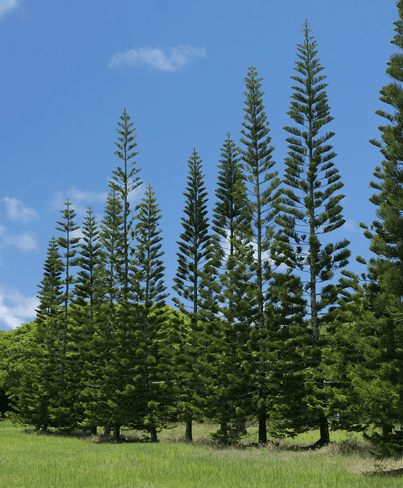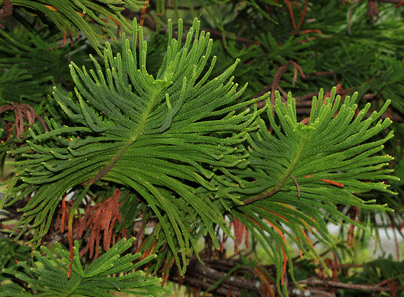Skinny pine trees, also known as columnar or narrow pines, are a type of pine tree distinguished by their upright, slender growth habit. They present a striking, elegant appearance that can enhance a wide range of landscape designs.
Key Characteristics:
- Height: These trees typically grow to heights ranging from 20 to 50 feet.
- Width: Skinny pines exhibit a narrow width, generally between 4 to 8 feet.
- Foliage: They feature long, slender needles, adding a soft, textured element to the landscape.
- Growth Habit: Their columnar shape makes them an excellent choice for tight spaces where a traditional pine tree would be too wide.
Climate Suitability for Skinny Pine Trees in Temecula
Temecula, CA boasts a Mediterranean climate, characterized by hot, dry summers and mild, wet winters. To evaluate if skinny pine trees are a suitable choice, let’s examine how their needs align with Temecula’s climate.
Temperature and Frost Tolerance:
Skinny pine trees generally tolerate a broad temperature range, including those prevalent in Temecula.
- Winter Temperatures: Temecula’s mild winters are well-suited for skinny pines, as they can withstand light frosts.
- Summer Heat: These trees are adept at handling hot, dry summers, provided they receive sufficient water.
Precipitation and Watering Needs:
Temecula experiences low rainfall during the summer months, so understanding how skinny pine trees cope with these conditions is crucial.
- Rainfall: Skinny pines prefer well-drained soil and can manage with less frequent watering once established.
- Irrigation: During dry periods, ensure regular watering to maintain the health of the trees.
Soil Conditions in Temecula, CA
Temecula’s soil can vary, but it is often sandy or loamy, generally well-draining. However, skinny pine trees demand specific soil conditions to flourish.
Soil Drainage:
Skinny pines require well-drained soil to prevent issues such as root rot. Stagnant water can lead to root damage and ultimately, tree decline.
Soil Type:
- Sandy loam or loamy soil is ideal for skinny pine trees. These soil types provide excellent drainage and allow for sufficient aeration of the roots.
- Heavy clay soils, which tend to retain moisture, can be improved by incorporating organic matter, such as compost or well-rotted manure.
Soil pH:
Skinny pine trees generally thrive in slightly acidic to neutral soil pH levels.

- Acidity: Test your soil to determine its pH. Aim for a pH level between 5.5 and 7.0. You can find soil testing kits at most garden centers.
- Soil Amendments: If your soil is too alkaline, you can amend it with pine bark or acidic fertilizers to adjust the pH.
Benefits of Planting Skinny Pine Trees in Temecula
Planting skinny pine trees in Temecula offers a multitude of benefits, making them an attractive option for many homeowners.

Space Efficiency:
Skinny pine trees are a fantastic choice for small gardens or urban spaces due to their narrow profile.
- Urban Gardens: They fit snugly in tight spots, such as along driveways or narrow garden beds, adding vertical interest without overwhelming the space.
- Privacy Screens: Their height and dense foliage create effective privacy screens and windbreaks, providing seclusion and protection from the elements.
Aesthetic Appeal:
These trees bring a touch of elegance and vertical interest to landscapes, adding dimension and visual appeal.
- Design Versatility: Their columnar shape complements various garden styles, from modern to traditional, providing a versatile design element.
- Year-Round Interest: Skinny pines remain attractive throughout the year, providing evergreen beauty even during the colder months.
Low Maintenance:
Skinny pine trees are generally low-maintenance, making them an excellent choice for busy gardeners.
- Drought Tolerance: Once established, these trees require less frequent watering, adapting well to Temecula’s dry summers.
- Pest Resistance: Skinny pines often resist common pests and diseases, reducing the need for extensive pest control measures.
Challenges and Considerations
While skinny pine trees offer numerous advantages, it’s essential to acknowledge potential challenges to ensure their successful growth and longevity.

Initial Establishment:
- Watering Needs: Newly planted trees require consistent watering to establish their root systems. Ensure the soil remains consistently moist during the first year to promote healthy root growth.
- Protection from Heat: Young trees, especially during their first few years, may need temporary shading to protect them from intense summer heat.
Potential Issues:
- Pest and Disease: Keep a vigilant eye out for pests like pine beetles and diseases such as pine wilt. Early detection and treatment are crucial to prevent significant damage.
- Root Space: Although skinny pine trees have a narrow canopy, they develop a relatively wide root system. Ensure adequate space is available for the roots to grow and spread.
How to Plant Skinny Pine Trees in Temecula
Proper planting techniques are paramount for the health and longevity of skinny pine trees. Here’s a step-by-step guide to ensure successful planting.
Choosing the Right Location:
- Sunlight: Select a location that receives full sun to partial shade. Skinny pines thrive in bright conditions.
- Spacing: Allow enough space for the tree to grow to its full height and width without obstructions from other plants or structures. Refer to the tree’s mature size for appropriate spacing.
Planting Steps:
- Prepare the Soil: Amend the soil with compost or other organic matter to improve fertility and drainage. This will provide a rich environment for the roots.
- Planting Depth: Place the tree in the hole so that the root collar, the point where the roots transition to the trunk, is level with the soil surface. Do not bury the root collar.
- Watering: Water the tree thoroughly after planting, ensuring the soil is evenly moistened. Continue to water regularly, especially during dry periods, until the tree is established.
- Mulching: Apply a layer of organic mulch, such as wood chips or shredded bark, around the base of the tree. Mulch helps retain moisture, suppress weeds, and regulate soil temperature.
Ongoing Care
Once planted, skinny pine trees require minimal care, but regular maintenance is essential for their health and vitality.
Watering:
Provide regular watering, particularly during dry spells. Newly planted trees need more frequent watering than established trees. As the tree matures, watering needs will decrease.
Fertilizing:
Use a balanced, slow-release fertilizer in the spring to support healthy growth. Avoid over-fertilizing, as this can harm the tree.
Pruning:
Prune as needed to maintain shape and remove dead or damaged branches. You can also prune to control the tree’s height or width. It’s best to prune during the dormant season, typically in late winter or early spring, to minimize stress on the tree.
Conclusion
If you’re wondering whether skinny pine trees are a good choice for your Temecula, CA garden, the answer is a resounding yes! Provided you consider their specific needs, these trees can thrive in Temecula’s climate and soil conditions with the right care. Their narrow profile, aesthetic appeal, and low maintenance requirements make them a valuable addition to many landscapes in Temecula.
By understanding the local conditions and following proper planting and care techniques, you can enjoy the benefits of skinny pine trees in your garden for years to come.
FAQs
What are some popular skinny pine tree varieties suitable for Temecula?
Popular skinny pine tree varieties for Temecula include:
- Monterey Cypress (Cupressus macrocarpa): A fast-growing evergreen with a columnar shape.
- Italian Cypress (Cupressus sempervirens): A classic columnar cypress with a distinctive, slender silhouette.
- Mugo Pine (Pinus mugo): A dwarf pine variety that grows in a compact, upright shape.
- Scotch Pine (Pinus sylvestris): Available in columnar cultivars with blue-green needles.
- Austrian Pine (Pinus nigra): A hardy pine species with a variety of columnar cultivars.
Do skinny pine trees attract pests or diseases?
While skinny pines are generally pest-resistant, they can be susceptible to certain pests and diseases, particularly pine beetles and pine wilt. Regular inspection and early detection are crucial for effective management.
How often should I water my skinny pine tree?
Newly planted trees require more frequent watering than established trees. Aim for deep watering once or twice a week, ensuring the soil is thoroughly moistened. As the tree matures, you can reduce watering frequency to once every two weeks or as needed, depending on the weather conditions.
Can I prune my skinny pine tree to maintain its shape?
Yes, you can prune skinny pine trees to maintain their shape. It’s best to prune during the dormant season, typically in late winter or early spring, to minimize stress on the tree. You can trim back any branches that are growing out of shape or interfering with other plants.
Are skinny pine trees suitable for coastal areas?
Some skinny pine varieties are well-suited for coastal areas. Monterey Cypress and Italian Cypress are known for their tolerance to salt spray and wind. However, it’s crucial to select varieties that are specifically recommended for coastal environments.
How long does it take for a skinny pine tree to reach its mature height?
The time it takes for a skinny pine tree to reach its mature height varies depending on the variety and growing conditions. Some varieties grow faster than others. Generally, it can take several years for a skinny pine tree to reach its full height.
Do skinny pine trees produce cones?
Yes, skinny pine trees produce cones. However, the size and shape of the cones can vary depending on the variety. Some skinny pines produce small, inconspicuous cones, while others have larger, more prominent cones.
What are the benefits of planting a skinny pine tree near a house?
Planting a skinny pine tree near a house can provide several benefits, including:
- Privacy: They can create a natural barrier for privacy from neighbors or street views.
- Aesthetics: They add a touch of elegance and vertical interest to the landscape.
- Windbreak: They can provide a natural windbreak, protecting the house from strong winds.
- Shade: They can provide shade for the house during hot summer months.
What are some alternatives to skinny pine trees for Temecula gardens?
If you’re looking for alternative evergreen trees for your Temecula garden, consider these options:
- Redwood (Sequoia sempervirens): A majestic evergreen that thrives in Mediterranean climates.
- Olive Tree (Olea europaea): A drought-tolerant evergreen with silvery-green leaves and attractive fruit.
- California Fan Palm (Washingtonia filifera): A native palm tree that adds a tropical touch to the landscape.
- Blue Spruce (Picea pungens): An evergreen with striking blue needles.
- Japanese Cedar (Cryptomeria japonica): A fast-growing evergreen with a pyramidal shape and soft, feathery foliage.
If you’re interested in learning more about tech news, feel free to visit my website: www.HowToGrowPlant.com.
